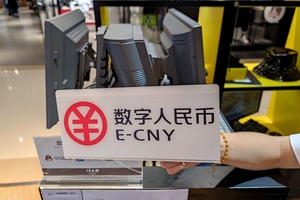Zhou Xiaochuan: China’s Choices in Developing Its Digital Currency System

Editor’s note: China will probably become the first major economy to officially launch a sovereign digital currency, which has long drawn attention from central bankers and fintech investors around the world. This article provides detailed explanation of the issue and what’s behind Beijing’s digital yuan ambitions.
* The development of China’s digital currency is not completely along the same path as many other countries’ central bank digital currencies
* It is risky for the central bank to single out a so-called optimal technology roadmap, and anti-monopoly efforts are required to clear hurdles to new technology routes
* The central bank’s R&D focus is more about building a reliable clearing and settlement infrastructure, but not about the digital currency itself
* Blockchain technology has some drawbacks such as failures to modify incorrect transactions due to its “tamper-proof” feature
* When promoting the use of its digital currency in cross-border transactions, China should avoid being accused of promoting “yuanization”
With the development of online nonbank payments, the People’s Bank of China (PBOC) extended its oversight to nonbank payment firms in the early 2010s, granting its first license to such a firm to Ant Group Co. Ltd.’s Alipay (link in Chinese) in 2011.
In 2014, the PBOC set up a project group on digital currency, but at the time didn’t make the technical direction clear. In 2016, the central bank established a research institute for the development of a digital currency.
In 2017, the PBOC launched a research project on its Digital Currency/Electronic Payment (DC/EP) system (数字货币/电子支付体系), and noticed some problems with digital assets trading that should not be confused with DC/EP. The same year, the financial regulator banned domestic Bitcoin trading and initial coin offerings (ICO).
Read more
5 Things to Know About China’s Crackdown on Initial Coin Offerings
In 2019, the PBOC announced it was starting pilot programs and closed testing of the digital yuan. In 2020, the central bank confirmed it was conducting internal trials of the digital currency in three cities — Shenzhen, Suzhou and Chengdu — as well as the Xiongan New Area near Beijing, and in hypothetical scenarios related to the 2022 Winter Olympics in the capital. Each of the three cities has a population between 10 million and 17 million, equivalent to that of a midsize European country.
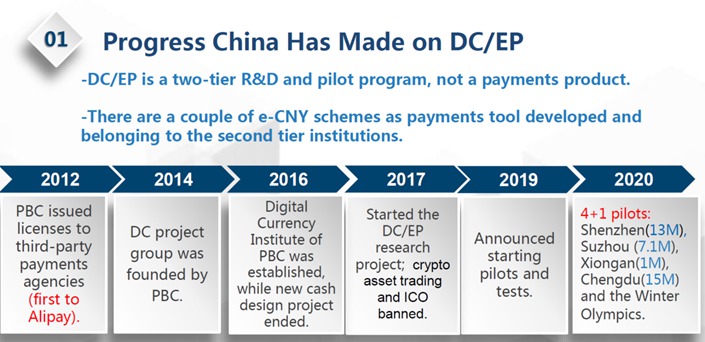 |
I’d like to make it clear that DC/EP is a two-tier research and development (R&D) and pilot program, rather than a payment product. In other words, the DC/EP program may involve several payment products that can be trialed and rolled out.
Under a two-tier system, second-tier institutions like commercial banks, telecom operators and online payment platforms can choose to cooperate with each other based on their preferences for payment products and technology frameworks.
 |
As of June 2020, Chinese mobile payment users accounted for nearly 60% of the country’s population. In 2019, mobile payments accounted for nearly 15% of all electronic payments, including credit card payments. Meanwhile, mobile payments accounted for 64% of personal consumption payments in 2019.
Why develop a digital currency?
Firstly, the driving force mainly comes from the demand side, as consumers hope to cut costs, improve convenience and obtain better services by enhancing the efficiency of the payments system, especially retail payments.
Admittedly, continuous advances in technology have made this possible. But it’s important to study both the supply of technology and needs of users. For example, blockchain technology features decentralization, but decentralization is not a necessity for modernizing the payments system. It even has some drawbacks.
Also, while the immutability of blockchain is useful, it is almost impossible to tamper with current systems, especially the account systems of established banks. And there are cases where incorrect transactions need to be modified.
Secondly, Chinese people prefer going out only with their mobile phones, which have digital wallets that hold cash and credit cards. That’s a huge demand motivation.
Thirdly, from the retailers’ side, they can handle a variety of payment methods, such as through near-field communication (NFC) systems or QR codes. Before the development of mobile payment, there were already a large number of retailers using the internet to acquire business.
With the improvement of internet infrastructure, the probability of internet failures is small. But as a backup system, peer-to-peer offline payments can be done using NFC technology, regardless of whether people are connected to the internet.
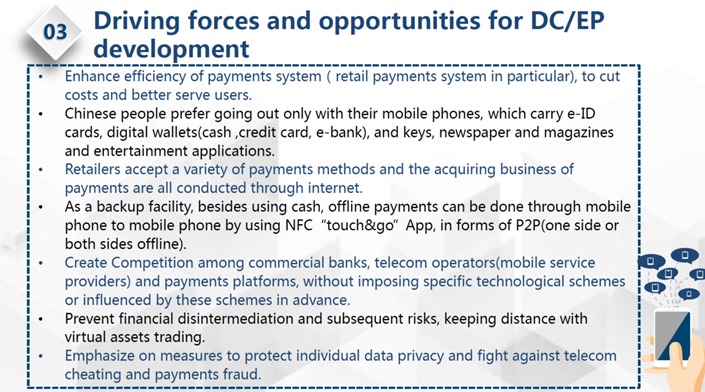 |
Fourthly, developing digital currency can boost competition among the second-tier commercial institutions. They can compete to offer services and make innovations, without being impacted by specific technological schemes.
Personally, I believe it would be better if the central bank does not decide in advance on a specific technological roadmap because it is hard to determine which one is the best as technology develops rapidly.
The fifth factor is the emphasis on measures to protect individual data privacy and fight against telecom and payments fraud. In China, fraud via mobile phones and other internet systems occurs often, which is a major concern of authorities and the public.
Regarding digitalization, banking is a data processing business to a large extent. Therefore, whether we are talking about the digital currency or data processing, it should be considered as digitalization in a broad sense.
Two-tier program
DC/EP is a dynamic two-tier and multi-scheme program. China’s central bank makes up the first tier, and is in charge of building stable financial infrastructure and supervising the whole program.
The second tier includes commercial banks, telecom operators and third-party payment platforms. Currently, the following are all involved in trial operations: the “Big Four” Chinese state-owned commercial banks: Industrial and Commercial Bank of China Ltd., Agricultural Bank of China Ltd., Bank of China Ltd. and China Construction Bank Corp.; three biggest state-owned carriers: China Mobile, China Unicom and China Telecom; and two payment service providers: Alipay and Tencent Holdings Ltd.’s Tenpay, which operates WeChat Pay.
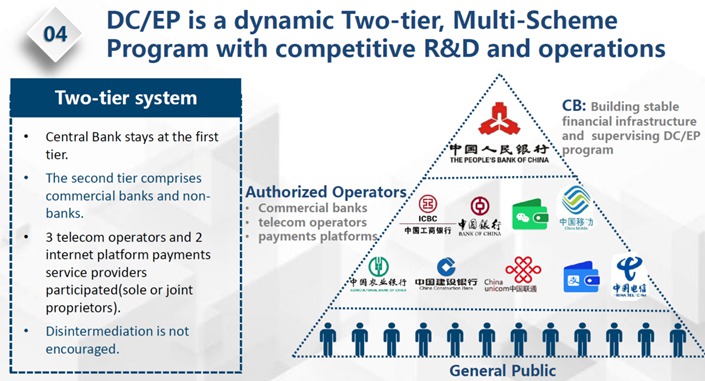 |
These second-tier institutions are highly motivated and aware of the great growth opportunities ahead, especially for acquiring clients and new business. But they should also take on greater responsibilities.
Firstly, they need to have enough capital to mitigate potential risks. Secondly, they should know their customers well and play a key role in fighting money laundering. Thirdly, they are largely responsible for protecting client privacy. In addition, they need to invest large sums in technology.
Of course, some institutions would like to stand to benefit more while taking on fewer of these responsibilities. But the central bank, standing at the first tier, will tell them they have to take on those responsibilities.
A country as large as China can allow different institutions at the second tier to make, develop and pilot different schemes. Meanwhile, it should be noted that coordination or unified interfaces may be required for some programs.
In a word, one of the important driving forces for developing a two-tier system in China is the great emphasis on the modernization of the retail payments system. The reason for focusing on the retail system is that it provides the underlying services for the entire payments system, and such a foundation should be made solid.
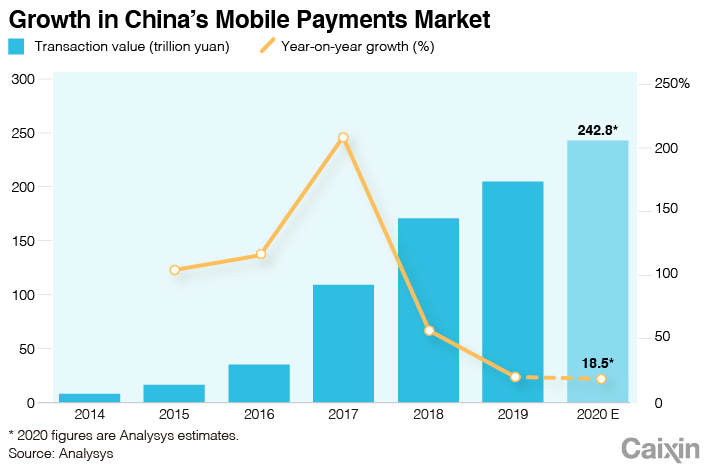 |
Why use a two-tier and multi-scheme dynamic evolution mechanism?
It is difficult and risky for the central bank to single out an optimal and sustainable technology roadmap. Meanwhile, China’s vast market with 1.4 billion people can allow application of multiple technological schemes.
It should be noted that it is easier for smaller countries to innovate, conduct pilots and switch plans. But it is difficult for a large country. It can take a very long time, during which a variety of risks can arise. Take replacing bank notes as an example. In some small European countries, it took around a year to replace paper money with plastic notes. But it has taken China 10 years or so to switch from the fourth set of the yuan to the fifth.
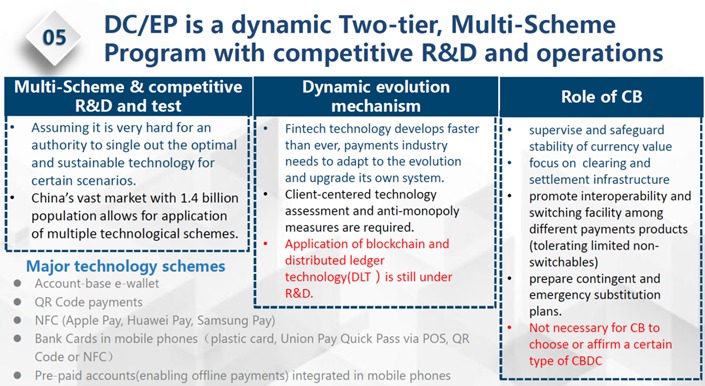 |
Due to the rapid development of fintech, the payments industry needs to adapt and upgrade its own system. Meanwhile, it’s important to constantly assess new technologies in a client-centered manner, and anti-monopoly measures are required to clear the hurdle to the next new technology route.
The possible application of blockchain and distributed ledger technology (DLT) is still being researched, but is not ready at this time. It has technical problems that still need to be solved, particularly its deficiency in the number of retail transactions it can handle per second. That means the technology has not become the mainstream in the retail payment system yet.
One of the main tasks of the PBOC is to safeguard the stability of the digital currency’s value by imposing capital requirements on the second-tier institutions.
Under the two-tier system, the central bank’s R&D focus may not be on the digital currency itself, but more on building a reliable clearing and settlement infrastructure. The infrastructure involves not only the retail payment system, but the economy’s broader payment infrastructure and the financial market’s infrastructure.
In addition, the central bank needs to promote interoperability and switching facility among different payment products, and prepare contingent and emergency substitution plans in case of failures in the second-tier institutions’ technical schemes.
Closer look at DC/EP
One technological solution for the DC/EP system can be account-based e-wallets. People can make payments through QR codes, prepaid cards, such as the Octopus card in Hong Kong, or NFC technology, which is used by Apple Pay, Samsung Pay and Huawei Pay.
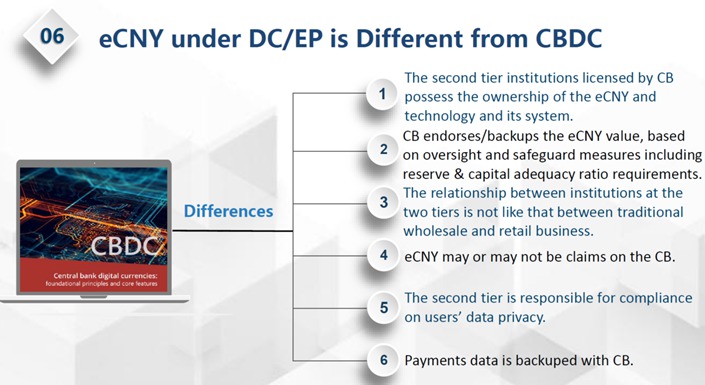 |
The development of DC/EP is not completely along the same path as the so-called mainstream central bank digital currency (CBDC), and it’s not a branch under that CBDC umbrella.
Firstly, second-tier institutions own the digital yuan. To some extent, this design draws lessons from Hong Kong’s three note-issuing banks. The three banks need to give $1 to the Hong Kong Monetary Authority (HKMA), the city’s de facto central bank, as a reserve for every HK$7.8 they issue. The HKMA then hand out certificates of indebtedness to the issuing banks. On the banks’ balance sheets, the notes they issue are entered as liabilities. And for the HKMA, the certificates of indebtedness are its liabilities. In this sense, DC/EP is different from the typical CBDC, which is owned and indebted by a central bank.
Secondly, the PBOC can ensure the stability of the digital yuan’s value through multiple approaches, including requiring banks to set aside money as reserves and then issuing them certificates of indebtedness or letters of comfort. Therefore, the composition of the two-tier system of DC/EP can be different.
Thirdly, the relationship between the PBOC and second-tier institutions is not necessarily like that between wholesale and retail businesses. Some people assume the central bank does wholesale business while the second-tier institutions do retail. But I think this is oversimplifying it, and there’s no need to frame it this way in order just to clarify it.
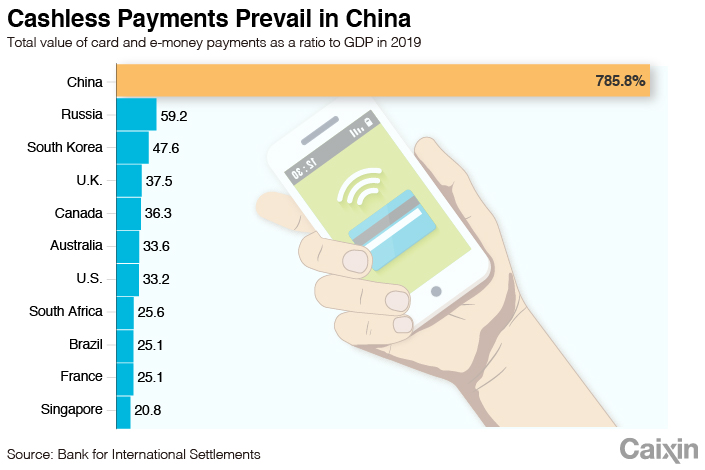 |
In addition, second-tier institutions need to bear the compliance responsibilities such as knowing their customers, anti-money laundering and protecting users’ data privacy. The PBOC should get access to relevant second-tier transaction data to better oversee compliance, but this is only for future reference and it does not get any direct business interest out of this.
Read more
In Depth: China’s Digital Currency Ambitions Lead the World
DC/EP’s two-tier system that’s being trialed now is the result of several years of development and communication between the PBOC and the market.
Globally, the mainstream concept of digital currency has been gradually formed through discussions among international financial institutions and central banks. In the early stage, the focus was on Bitcoin. At the time, it was widely agreed to be unstable, or not even a currency, so the concept of stablecoin later emerged. Then Facebook’s Libra, a type of personal cryptocurrency, came out, but many worried it could cause all sorts of problems. So, they said they didn’t want a personal digital currency but a CBDC. But then concerns emerged over financial disintermediation caused by CBDC which could lead to unprecedented risks, so people started to support a two-tier CBDC.
Read more
In Depth: Facebook’s Cryptocurrency Ambition
Discussions on these issues took place quite early in China. When some people were obsessed with Bitcoin, the PBOC was aware it did not meet the needs of the payment system and in 2017 banned ICOs and Bitcoin trading in China. Also, when the wholesale-retail relationship was referenced between central banks and second-tier institutions, the PBOC was considering a relationship between infrastructure and business services.
Protection of data privacy
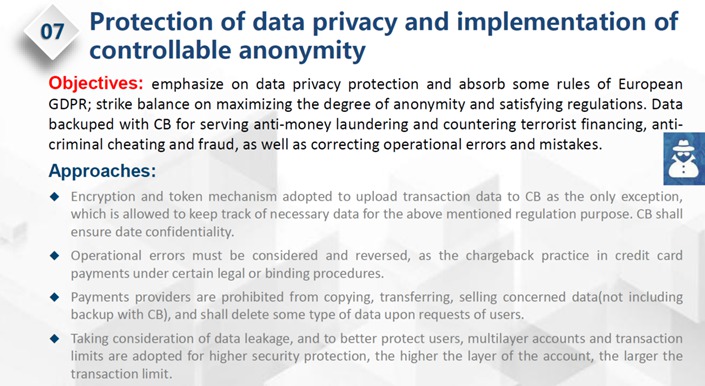
Retail transactions need to be protected for privacy and an anonymity mechanism should be in place. But authorities, especially anti-money laundering and anti-drug agencies, should have access to related data while trying their best to protect privacy. I have been advocating the idea of finding a balance point. The central bank should guarantee its support for pushing technology forward, and study some of the rules in the European Union’s General Data Protection Regulation.
In recent years, massive data leaks have occurred in China. Involved institutions should erase the leaked data, and users should change their passwords or register new accounts. But it’s so much of a hassle to do that, and doing so sometimes may not result in anything effective. So, there are needs for other ways to safeguard the safety of users’ funds and data. There is already a lot of private data flowing illegally into the market, and something needs to be done to deal with it.
Progress in blockchain
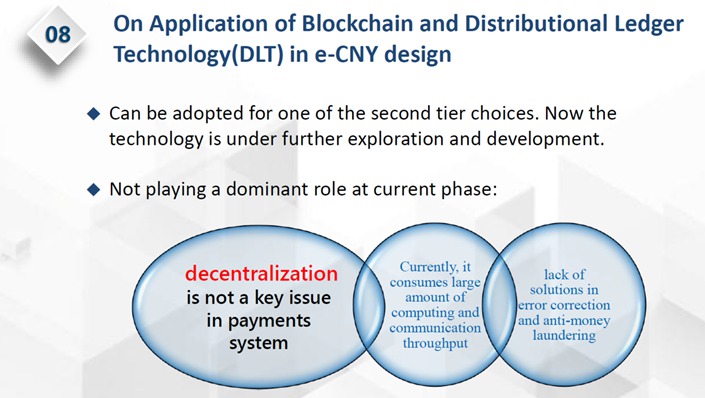
The application of blockchain and DLT has made some progress in trials in nonpayment fields in the financial system. But DLT has yet to play a key role in the current phase of the payment industry, given the large number of transactions.
Another issue is the need to correct errors in the payment system. For example, if a credit card payment is made by accident, the transaction needs to be canceled and the record needs to be removed. Otherwise, the information could be mistakenly entered on the user’s credit record. Such a demand conflicts with the “tamper-proof” blockchain feature.
Demands for cross-border payments
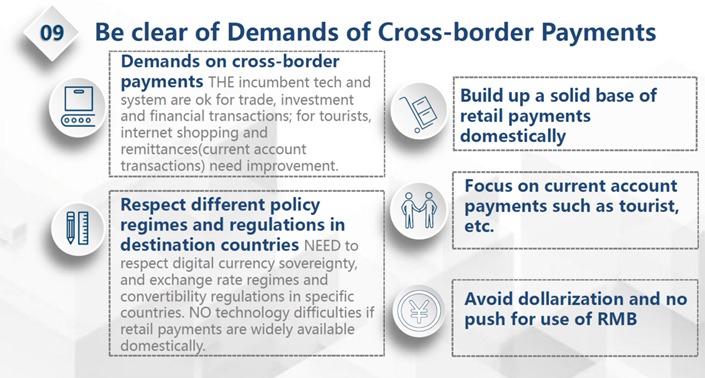
When Libra was launched, it targeted cross-border payments as its main application goal, but doubts emerged over dollarization.
Also, the difficulties linked to cross-border payments don’t really involve technical systems, but risks related to currency exchange and management of capital inflow and outflow. For example, if Mexican migrants in the U.S. want to transfer money back home using Libra, they have to exchange it for Mexican pesos if Libra is not widely accepted in Mexico. Therefore, it’s necessary to focus more on the retail application rather than on cross-border money transfer.
In addition, the international community is often concerned about money laundering, terrorist financing and drug dealing. For China, gambling is also an issue.
That said, the current technology can solve many technical issues and support convenient payment approaches. China and other East Asian countries can steadily push ahead on cross-border transactions using digital currency. That process could come with the internationalization of the yuan, which should not be overly promoted. And China should avoid being accused of promoting “yuanization.”
Zhou Xiaochuan is a former governor of the PBOC and current vice chairman of nonprofit international organization Boao Forum for Asia.
This article is based on Zhou’s speech to a seminar at Peking University on Nov. 27. It reflects his personal views instead of any organization’s. It has been edited for length and clarity.
Contact translators Luo Meihan (meihanluo@caixin.com), Timmy Shen (hongmingshen@caixin.com) and Lu Yutong (yutonglu@caixin.com) and editor Michael Bellart (michaelbellart@caixin.com)
Download our app to receive breaking news alerts and read the news on the go.

- MOST POPULAR


